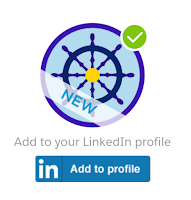
Arrr. Me hearties. Tis time for another Trailhead module review... this time, no battleships, but PIRATE ships, as we Navigate our way through the Salesforce Advantage Sea...
Learn about the key differentiators that drive our success: our core values, innovative technology, and vibrant ecosystem.
So go throw on yer best sailing hat, grab yer cutless and join me on a sailing adventure across all that this great module has to offer!
This here module is a little different to t'others ye might have done in the past.. it's not got the technicals, ye won't be needin' yer fiddly code or clicks, but what you will be gainin' is a mighty haul of treasured information on
why Salesforce is the greatest ship to float on that there Internet, both for yourself, and yer piratin' business.

B'fore ye gets to the wheel house though, yer gotta start down scrubbing barnacles off the belly of the boat.. Module 1 covers the 4 cornerstone philosophies of why Salesforce be the best in the market for not only Cloud CRM.. but every part of yer business. Don't fret too hard on the quiz, no-one is getting hung and drawn in this exam, it's as easy as taking candy from a French merchant ship. There be a truly
terrifying picture of Marc Benioff from 1999 in there though, so brace yerself for that.
Once yer've snagged yerself a ships wheel for your efforts... why not boast to all your buccaneer buddies over in LinkedIn, with the SSO link. All true pirates use LinkedIn you know.
Module 2 be on all the bits of the great ship Salesforce from the Masts (lets say that's Sales cloud) to the decking (the AppExchange maybe?) it all be there ready and available for you to sale your way to success. A good pirate knows his way around his ship, and this module gives you an idea of how bigger boat you've got. Speaking of size, if ye get yer britches in a twist on the exam in this module... the answers are the longest, most expansive ones ;)

Arrrgghhh!! Whats this?! Does a storm be a brewin'?! Oh... no... it's just the Clouds coming in, the second half of this module explains why not having to worry about all that computer hardware, servers, backup, multiple-OS configuration is so
amazing.. Salesforce is one ship that's NOT afraid of a bit of cloudy weather, in fact, it was one of the pioneers of Sailing on the cloud, and will continue to be so for some time.
Answer a couple more questions to get the next bit of yer ship together, the prop, now we're going places!
The next module says it will take 5 minutes, and that's only if you decide to sit and ponder the quote from Parker Harris for 2 minutes... it's a bit of a doozy to be sure, but that's because it's the simplest concept ever - how to trust the Cloud. When you get to the quiz on this module... see if you can work out why I got question 2 wrong:
It's harder than ye be believin'
In
learning the value of multitennancy we find out what having all our pirate buddies about is about, and why its actually quite a cool thing. I wish when I lived on my own I had a door man, and if I'd lived in the cloud I could have done.
The next chapter in this module is on MetaData, so we be startin' to get a little more technical.. but there is really only one thing you need to know about this module is that at 1:24 in the video..
a pig uses Salesforce1. I think my next Developer Edition exploration will have to be a farm, I've never done that before! (oh, we're supposed to be pirates aren't we... ahem.. arrrhhhhh). The key to Davey Jones' locker here is that Metadata is
everything you have defined in the cloud, and that it is yours, it is safe and secure, but it is based on the same powerful platform that some of the biggest and most successful businesses use.
For a developer style ship mate, this next module is an interesting one, I feel like it gives the world a good impression of what we do, but no-one really likes seeing their job described as being "5 times faster" than usual... I can almost hear my deadlines screeching in around me ;) keep your cannons loaded though and you'll be able to keep those milestones at bay.
I'll also be honest to the pirates code, and say that question three is a tricky one for me, because I freaking love coding. But I kept it together and fired the canon ball to the back of the net for another 100 points, and another badge on my pantaloons.
The final module on this vast voyage starts with Community. This is a personal favourite of mine, as I am almost entirely submerged in what is really a
global community of Salesforce developers and experts. As I organise the my local Developer User Group here in Bristol (UK), and attend our User Group, as well as other groups around the country.. I have also had the pleasure of attending Dreamforce in San Francisco, and the MVP summit in the same city.
I have genuinely got to a point now, where it is as easy and quick for me to pop a question on the Internet to get help with a Salesforce question as it is to turn to the people in the room with me.
The final chapter, err.... Meet an MVP?! Well, Hello! If you have made it this far into one of my blog posts, I already probably consider you a closer ship-mate than you'd imagine. Here be my pirate calling card.. get in touch whenever you need!

Captain Simon Lawrence
If you need any other MVPs in the Bristol area, feel free to pop a tweet to my colleagues
@adtennant or
@jenny_bamber, or indeed dig up Chris Lewis, Matthew Morris or Simon Goodyear.
So that be the journey completed, get those badges on your profile! You're half way to having your own Pirate ship...
 But what is Surf Force?
But what is Surf Force?










